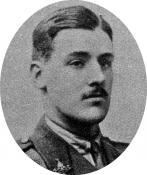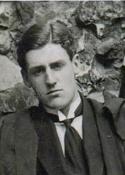
|
The King's School Canterbury |
Roll of Honour |
| Captain Lewis Wilberforce GOLDSMITH | |
|
A Company, 7th (Service) Battalion Yorkshire Regiment (Green Howards) Date of birth: 9th July 1895 Date of death: 5th November 1916 Killed in action aged 21 Commemorated on the Thiepval Memorial Panel and Face 3A and 3D |

|
| He was born at 57 Burnt Ash Hill, Lee in Kent on the 9th of July 1895 the eldest son of Francis Thomas Wilberforce Goldsmith, architect, and Mary Honor (nee Garland) later of "St Leonards", Foots Cray Lane, Sidcup. He was educated at Merton Court Preparatory School in Sidcup and at the King's School Canterbury from January 1910 to July 1914 where he was granted a Junior Scholarship in July 1910 and a Senior Scholarship in June 1913. He was a keen rower and rugby player, playing in the Rugby XV from 1912 to 1914, winning his colours in 1912. In March 1914 the Cantuarian made the following comments on his rugby season:- "Useful in the open and is fairly fast. Does not do a great deal of work in the scrum. very fair tackler." He was appointed as a school monitor in September 1913. He was elected as Hon Secretary of the Debating Society on the 20th of September 1913. He was a member of the Officer Training Corps and passed the practical paper for Certificate A in February 1914. He was entered for St John's College Oxford in 1914 but instead he applied for a commission in the infantry on the 21st of August 1914. He underwent a medical examination at Oxford on the same day where it was recorded that he was five feet ten inches tall and that he weighed 131lbs. He was commissioned as a 2nd Lieutenant in the Yorkshire Regiment on the 1st of September 1914 being promoted to Lieutenant on the 19th of November 1914 and was posted to the 7th Battalion of his regiment. He was promoted to Temporary Captain on the 5th of April 1915 and embarked for France with his battalion from Folkestone at 10.30pm on the 13th of July 1915, landing at Boulogne at 3.30am the next morning. He saw action on the first day of the Battle of the Somme, being one of the few officers in the battalion to be neither killed nor wounded during the day. He saw action with the battalion through the summer on the Somme and, on the 4th of November 1916, the battalion received orders to carry out a 'small attack' against an enemy trench which ran up to the edge of the road to Le Transloy. It was decided that in view of the relatively small objective that A Company alone would be sufficient to make the attack. At 10am on the morning of the 5th of November 1916 the British artillery opened up a heavy fire which intensified onto the enemy front line at 11.10am, when A Company went over the top to the attack. Soon after midday the officer commanding the neighbouring battalion of the East Yorkshire Regiment reported that he could see the enemy 'running like hell' and this was soon corroborated by Lieutenant Robertson of A Company. The enemy, on seeing the small size of the attacking force, soon turned and opened fire causing heavy casualties including Lewis Goldsmith who was severely wounded. He was being carried to the rear on a stretcher when he was struck and killed by machine gun fire which also killed three of the stretcher bearers. It was thought by eyewitnesses that this had been a deliberate act by the Germans. His father received the following telegram dated the 8th of November 1916: - "Deeply regret to inform you that Capt. L.W. Goldsmith was killed in action Nov. 5th. The Army Council express their sympathy." Eyewitness accounts were gathered in order to establish what had happened to him. Statement of Private 24507 William M. Green, 4 Platoon, A Company, 7th Battalion Yorkshire Regiment taken at Horton County of London War Hospital, Epsom on the 20th of March 1917: - "Description: Was Company Commander of A Company. A very smart man, rather round face. I saw the stretcher bearers carrying Capt. Goldsmith's body back to our lines at night, after attack in front of Bapaume. He was wounded in no man's land during the attack (about 11.30am) and was shortly after killed instantaneously by a whizz bang about 20 yards from our trenches. I know nothing about his burial but as a I know they brought his body back to our lines he would probably been buried behind the lines." Statement of Private 11740 William Todd C Company, 7th Battalion Yorkshire Regiment taken at 1st Southern General Hospital, Dudley Road, Birmingham on the 23rd of January 1917:- "I saw Capt. Goldsmith wounded in an attack between 8am and 9am on Nov. 5th he was hit by a bullet and put in a shell holes for the time being. Later on a German sniper saw him in the shell hole and killed him outright. He was taken out at night and buried near Les Boeufs." His Commanding Officer, Lieutenant Colonel Fife CMG, wrote:- "You son was killed by a rifle bullet when most gallantly leading his company against an enemy trench... Your son's death has been a great grief to me, for I had formed a high opinion of his character. In spite of his extreme youth he had commanded his company with marked ability and had always behaved with great ability in the field. I consider that, had he been spared, his career as a soldier might have been brilliant." 2nd Lieutenant W.D. Wilkinson wrote of his late Captain:- "He was leading his men with conspicuous gallantry in an attack on an enemy trench opposite. Everyone who was there bears witness to the eagerness and dash with which he went into action, and the cheerfulness with which he faced death on this last of many occasions. I have served under him for the last year out here, and I never knew a Company Officer more thoughtful and considerate to his Subalterns, more conscientious, or more devoted to his ideals." He is commemorated on the war memorial at Foots Cray, Sidcup, on the memorial at Merton Court Preparatory School and on the memorial at St John's College Oxford. |
|
 | |
Back